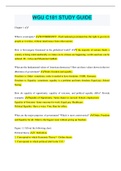Summary
Summary All definitions for chemistry Grade 11 and 12 (IEB)
- Course
- Institution
A simple document containing all the chemistry definitions that you will need to know for the IEB chemistry syllabus.
[Show more]Some examples from this set of practice questions
1.
Define: vector quantity
Answer: A physical quantity that has both magnitude and direction.
2.
Define: scalar quantity
Answer: A physical quantity that has magnitude only.
3.
Define: resultant vector
Answer: A single vector which has the same effect as the original vectors acting together.
4.
Define: distance
Answer: The length of the path travelled (is a scalar).
5.
Define: displacement
Answer: A change in position (is a vector).
6.
Define: speed
Answer: The rate of change of distance (is a scalar).
7.
Define: velocity
Answer: The rate of change of position (is a vector). OR The rate of change of displacement (is a vector). OR The rate of displacement (is a vector).
8.
Define: acceleration
Answer: The rate of change of velocity (is a vector).
9.
Define: weight
Answer: The gravitational force the Earth exerts on any object on or near its surface.
10.
Define: normal force
Answer: The perpendicular force exerted by a surface on an object in contact with it.
Some examples from this set of practice questions
1.
Define: molar mass
Answer: The mass in grams of one mole of that substance.
2.
Define: solution
Answer: A homogenous mixture of solute and solvent.
3.
Define: solute
Answer: The substance that is dissolved in the solution.
4.
Define: solvent
Answer: The substance in which another substance is dissolved, forming a solution.
5.
Define: concentration
Answer: The amount of solute per unit volume of solution.
6.
Define: yield
Answer: A measure of the extent of a reaction, generally measured by comparing the amount of product against the amount of product that is possible.
7.
Define: intramolecular bond
Answer: A bond which occurs between atoms within molecules.
8.
Define: covalent bond
Answer: A sharing of at least one pair of electrons by two non-metal atoms.
9.
Define: non-polar / pure covalent bond
Answer: An equal sharing of electrons.
10.
Define: polar covalent bond
Answer: Unequal sharing of electrons leading to a dipole forming (due to difference in electronegativity).

Stuvia customers have reviewed more than 700,000 summaries. This how you know that you are buying the best documents.

You can quickly pay through credit card or Stuvia-credit for the summaries. There is no membership needed.

Your fellow students write the study notes themselves, which is why the documents are always reliable and up-to-date. This ensures you quickly get to the core!
You get a PDF, available immediately after your purchase. The purchased document is accessible anytime, anywhere and indefinitely through your profile.
Our satisfaction guarantee ensures that you always find a study document that suits you well. You fill out a form, and our customer service team takes care of the rest.
Stuvia is a marketplace, so you are not buying this document from us, but from seller AllInOneHelper. Stuvia facilitates payment to the seller.
No, you only buy these notes for $0.00. You're not tied to anything after your purchase.
4.6 stars on Google & Trustpilot (+1000 reviews)
75632 documents were sold in the last 30 days
Founded in 2010, the go-to place to buy study notes for 14 years now
